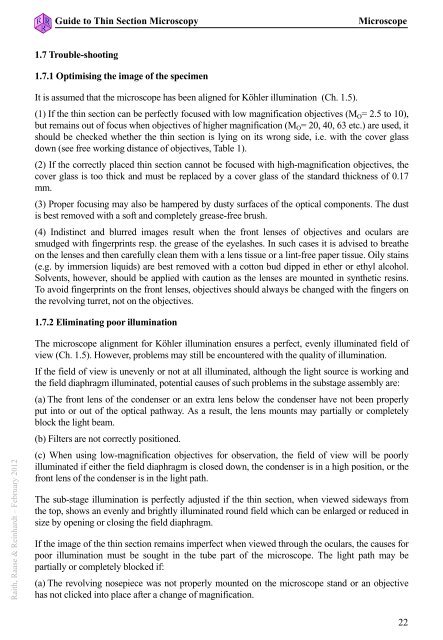guide to thin section microscopy - Mineralogical Society of America
guide to thin section microscopy - Mineralogical Society of America
guide to thin section microscopy - Mineralogical Society of America
Create successful ePaper yourself
Turn your PDF publications into a flip-book with our unique Google optimized e-Paper software.
Guide <strong>to</strong> Thin Section Microscopy<br />
Microscope<br />
1.7 Trouble-shooting<br />
1.7.1 Optimising the image <strong>of</strong> the specimen<br />
It is assumed that the microscope has been aligned for Köhler illumination (Ch. 1.5).<br />
(1) If the <strong>thin</strong> <strong>section</strong> can be perfectly focused with low magnification objectives (M O = 2.5 <strong>to</strong> 10),<br />
but remains out <strong>of</strong> focus when objectives <strong>of</strong> higher magnification (M O = 20, 40, 63 etc.) are used, it<br />
should be checked whether the <strong>thin</strong> <strong>section</strong> is lying on its wrong side, i.e. with the cover glass<br />
down (see free working distance <strong>of</strong> objectives, Table 1).<br />
(2) If the correctly placed <strong>thin</strong> <strong>section</strong> cannot be focused with high-magnification objectives, the<br />
cover glass is <strong>to</strong>o thick and must be replaced by a cover glass <strong>of</strong> the standard thickness <strong>of</strong> 0.17<br />
mm.<br />
(3) Proper focusing may also be hampered by dusty surfaces <strong>of</strong> the optical components. The dust<br />
is best removed with a s<strong>of</strong>t and completely grease-free brush.<br />
(4) Indistinct and blurred images result when the front lenses <strong>of</strong> objectives and oculars are<br />
smudged with fingerprints resp. the grease <strong>of</strong> the eyelashes. In such cases it is advised <strong>to</strong> breathe<br />
on the lenses and then carefully clean them with a lens tissue or a lint-free paper tissue. Oily stains<br />
(e.g. by immersion liquids) are best removed with a cot<strong>to</strong>n bud dipped in ether or ethyl alcohol.<br />
Solvents, however, should be applied with caution as the lenses are mounted in synthetic resins.<br />
To avoid fingerprints on the front lenses, objectives should always be changed with the fingers on<br />
the revolving turret, not on the objectives.<br />
1.7.2 Eliminating poor illumination<br />
Raith, Raase & Reinhardt – February 2012<br />
The microscope alignment for Köhler illumination ensures a perfect, evenly illuminated field <strong>of</strong><br />
view (Ch. 1.5). However, problems may still be encountered with the quality <strong>of</strong> illumination.<br />
If the field <strong>of</strong> view is unevenly or not at all illuminated, although the light source is working and<br />
the field diaphragm illuminated, potential causes <strong>of</strong> such problems in the substage assembly are:<br />
(a) The front lens <strong>of</strong> the condenser or an extra lens below the condenser have not been properly<br />
put in<strong>to</strong> or out <strong>of</strong> the optical pathway. As a result, the lens mounts may partially or completely<br />
block the light beam.<br />
(b) Filters are not correctly positioned.<br />
(c) When using low-magnification objectives for observation, the field <strong>of</strong> view will be poorly<br />
illuminated if either the field diaphragm is closed down, the condenser is in a high position, or the<br />
front lens <strong>of</strong> the condenser is in the light path.<br />
The sub-stage illumination is perfectly adjusted if the <strong>thin</strong> <strong>section</strong>, when viewed sideways from<br />
the <strong>to</strong>p, shows an evenly and brightly illuminated round field which can be enlarged or reduced in<br />
size by opening or closing the field diaphragm.<br />
If the image <strong>of</strong> the <strong>thin</strong> <strong>section</strong> remains imperfect when viewed through the oculars, the causes for<br />
poor illumination must be sought in the tube part <strong>of</strong> the microscope. The light path may be<br />
partially or completely blocked if:<br />
(a) The revolving nosepiece was not properly mounted on the microscope stand or an objective<br />
has not clicked in<strong>to</strong> place after a change <strong>of</strong> magnification.<br />
22
















